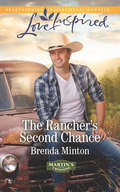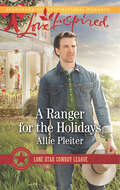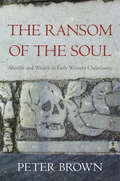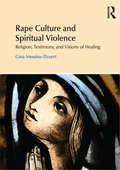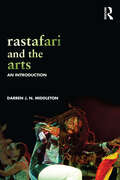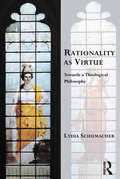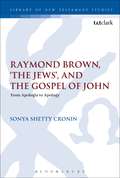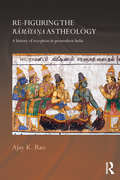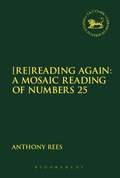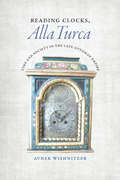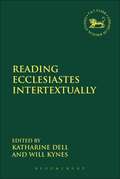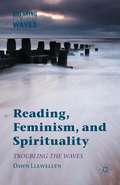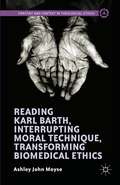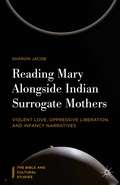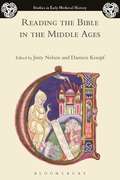- Table View
- List View
The Rancher's Second Chance: The Rancher's Second Chance Lakeside Hero An Alaskan Wedding (Martin's Crossing #3)
by Brenda MintonReunited with the Cowboy
A Ranger For The Holidays: A Ranger For The Holidays Gift-wrapped Family Holiday Homecoming (Lone Star Cowboy League #3)
by Allie PleiterA Christmas to Remember
The Ransom of the Soul: Afterlife and Wealth in Early Western Christianity
by Peter BrownA Choice Outstanding Academic Title of the Year A Tablet Book of the Year Marking a departure in our understanding of Christian views of the afterlife from 250 to 650 CE, The Ransom of the Soul explores a revolutionary shift in thinking about the fate of the soul that occurred around the time of Rome’s fall. Peter Brown describes how this shift transformed the Church’s institutional relationship to money and set the stage for its domination of medieval society in the West. “[An] extraordinary new book…Prodigiously original—an astonishing performance for a historian who has already been so prolific and influential…Peter Brown’s subtle and incisive tracking of the role of money in Christian attitudes toward the afterlife not only breaks down traditional geographical and chronological boundaries across more than four centuries. It provides wholly new perspectives on Christianity itself, its evolution, and, above all, its discontinuities. It demonstrates why the Middle Ages, when they finally arrived, were so very different from late antiquity.” —G. W. Bowersock, New York Review of Books “Peter Brown’s explorations of the mindsets of late antiquity have been educating us for nearly half a century…Brown shows brilliantly in this book how the future life of Christians beyond the grave was influenced in particular by money. —A. N. Wilson, The Spectator
The Ransom of the Soul: Afterlife and Wealth in Early Western Christianity
by Peter BrownA Choice Outstanding Academic Title of the Year A Tablet Book of the Year Marking a departure in our understanding of Christian views of the afterlife from 250 to 650 CE, The Ransom of the Soul explores a revolutionary shift in thinking about the fate of the soul that occurred around the time of Rome’s fall. Peter Brown describes how this shift transformed the Church’s institutional relationship to money and set the stage for its domination of medieval society in the West. “[An] extraordinary new book…Prodigiously original—an astonishing performance for a historian who has already been so prolific and influential…Peter Brown’s subtle and incisive tracking of the role of money in Christian attitudes toward the afterlife not only breaks down traditional geographical and chronological boundaries across more than four centuries. It provides wholly new perspectives on Christianity itself, its evolution, and, above all, its discontinuities. It demonstrates why the Middle Ages, when they finally arrived, were so very different from late antiquity.” —G. W. Bowersock, New York Review of Books “Peter Brown’s explorations of the mindsets of late antiquity have been educating us for nearly half a century…Brown shows brilliantly in this book how the future life of Christians beyond the grave was influenced in particular by money. —A. N. Wilson, The Spectator
Rape Culture and Spiritual Violence: Religion, Testimony, and Visions of Healing (Religion and Violence)
by Gina Messina-DysertRape Culture and Spiritual Violence examines sexual violence against women, how religion and society contribute to a rape culture, and the extreme suffering endured by rape victims as a result. Using the testimony of women who have experienced both rape and the consequences of rape culture—from a range of religious, cultural, ethnic, and social contexts—the book explores both the suffering and healing of rape victims from World War II to today. Among the issues considered are victim invisibility, the inability to express pain, and the tendency to assume shame and self-blame. The study examines the role of society in shaping and reinforcing these responses, contributing to traumas that can lead to spiritual death. The book also explores possibilities for multiple spiritual resurrections within the practice of daily life, encouraging both individual healing and social change.
Rape Culture and Spiritual Violence: Religion, Testimony, and Visions of Healing (Religion and Violence)
by Gina Messina-DysertRape Culture and Spiritual Violence examines sexual violence against women, how religion and society contribute to a rape culture, and the extreme suffering endured by rape victims as a result. Using the testimony of women who have experienced both rape and the consequences of rape culture—from a range of religious, cultural, ethnic, and social contexts—the book explores both the suffering and healing of rape victims from World War II to today. Among the issues considered are victim invisibility, the inability to express pain, and the tendency to assume shame and self-blame. The study examines the role of society in shaping and reinforcing these responses, contributing to traumas that can lead to spiritual death. The book also explores possibilities for multiple spiritual resurrections within the practice of daily life, encouraging both individual healing and social change.
Rastafari and the Arts: An Introduction
by Darren J. MiddletonDrawing on literary, musical, and visual representations of and by Rastafari, Darren J. N. Middleton provides an introduction to Rasta through the arts, broadly conceived. The religious underpinnings of the Rasta movement are often overshadowed by Rasta’s association with reggae music, dub, and performance poetry. Rastafari and the Arts: An Introduction takes a fresh view of Rasta, considering the relationship between the artistic and religious dimensions of the movement in depth. Middleton’s analysis complements current introductions to Afro-Caribbean religions and offers an engaging example of the role of popular culture in illuminating the beliefs and practices of emerging religions. Recognizing that outsiders as well as insiders have shaped the Rasta movement since its modest beginnings in Jamaica, Middleton includes interviews with members of both groups, including: Ejay Khan, Barbara Makeda Blake Hannah, Geoffrey Philp, Asante Amen, Reggae Rajahs, Benjamin Zephaniah, Monica Haim, Blakk Rasta, Rocky Dawuni, and Marvin D. Sterling.
Rastafari and the Arts: An Introduction
by Darren J. MiddletonDrawing on literary, musical, and visual representations of and by Rastafari, Darren J. N. Middleton provides an introduction to Rasta through the arts, broadly conceived. The religious underpinnings of the Rasta movement are often overshadowed by Rasta’s association with reggae music, dub, and performance poetry. Rastafari and the Arts: An Introduction takes a fresh view of Rasta, considering the relationship between the artistic and religious dimensions of the movement in depth. Middleton’s analysis complements current introductions to Afro-Caribbean religions and offers an engaging example of the role of popular culture in illuminating the beliefs and practices of emerging religions. Recognizing that outsiders as well as insiders have shaped the Rasta movement since its modest beginnings in Jamaica, Middleton includes interviews with members of both groups, including: Ejay Khan, Barbara Makeda Blake Hannah, Geoffrey Philp, Asante Amen, Reggae Rajahs, Benjamin Zephaniah, Monica Haim, Blakk Rasta, Rocky Dawuni, and Marvin D. Sterling.
Rationality as Virtue: Towards a Theological Philosophy (Transcending Boundaries in Philosophy and Theology)
by Lydia SchumacherFor much of the modern period, theologians and philosophers of religion have struggled with the problem of proving that it is rational to believe in God. Drawing on the thought of Thomas Aquinas, this book lays the foundation for an innovative effort to overturn the longstanding problem of proving faith's rationality, and to establish instead that rationality requires to be explained by appeals to faith. To this end, Schumacher advances the constructive argument that rationality is not only an epistemological question concerning the soundness of human thoughts, which she defines in terms of ’intellectual virtue’. Ultimately, it is an ethical question whether knowledge is used in ways that promote an individual's own flourishing and that of others. That is to say, rationality in its paradigmatic form is a matter of moral virtue, which should nonetheless entail intellectual virtue. This conclusion sets the stage for Schumacher's argument in a companion book, Theological Philosophy, which explains how Christian faith provides an exceptionally robust rationale for rationality, so construed, and is intrinsically rational in that sense.
Rationality as Virtue: Towards a Theological Philosophy (Transcending Boundaries in Philosophy and Theology)
by Lydia SchumacherFor much of the modern period, theologians and philosophers of religion have struggled with the problem of proving that it is rational to believe in God. Drawing on the thought of Thomas Aquinas, this book lays the foundation for an innovative effort to overturn the longstanding problem of proving faith's rationality, and to establish instead that rationality requires to be explained by appeals to faith. To this end, Schumacher advances the constructive argument that rationality is not only an epistemological question concerning the soundness of human thoughts, which she defines in terms of ’intellectual virtue’. Ultimately, it is an ethical question whether knowledge is used in ways that promote an individual's own flourishing and that of others. That is to say, rationality in its paradigmatic form is a matter of moral virtue, which should nonetheless entail intellectual virtue. This conclusion sets the stage for Schumacher's argument in a companion book, Theological Philosophy, which explains how Christian faith provides an exceptionally robust rationale for rationality, so construed, and is intrinsically rational in that sense.
Raymond Brown, 'The Jews,' and the Gospel of John: From Apologia to Apology (The Library of New Testament Studies #504)
by Sonya Shetty CroninUntil the mid-1960s, most commentators of the Gospel of John were aware of a polemic against 'the Jews,' yet they did not consider it with reference to contemporary ethical discussion. A shift in focus in Johannine scholarship is noticeable from the mid-1960s and 1970s to the present, where commentators began to connect the Gospel's polemic against 'the Jews' with potential anti-Judaism in the text. As yet, very little work has been done to answer the question of how this change in sensitivity came about. This book is a historiography of one scholar's growing awareness of potential anti-Judaism in the Gospel of John with the intention of using this individual history to explain the larger trend in biblical studies. Sonya Cronin examines the published work of Raymond Brown, a prominent Catholic New Testament scholar, between the years 1960-1998. The book contextualizes Brown's work by evaluating the impact of ecclesiastical statements and the influence of earlier and contemporary Johannine scholarship on Brown's biblical interpretation, and then posits theories as to why change occurs at specific times.
Re-figuring the Ramayana as Theology: A History of Reception in Premodern India (Routledge Hindu Studies Series)
by Ajay K. RaoThe Rāmāyana of Vālmīki is considered by many contemporary Hindus to be a foundational religious text. But this understanding is in part the result of a transformation of the epic’s receptive history, a hermeneutic project which challenged one characterization of the genre of the text, as a work of literary culture, and replaced it with another, as a work of remembered tradition. This book examines Rāmāyana commentaries, poetic retellings, and praise-poems produced by intellectuals within the Śrīvaisnava order of South India from 1250 to 1600 and shows how these intellectuals reconceptualized Rāma’s story through the lens of their devotional metaphysics. Śrīvaisnavas applied innovative interpretive techniques to the Rāmāyana, including allegorical reading, ślesa reading (reading a verse as a double entendre), and the application of vernacular performance techniques such as word play, improvisation, repetition, and novel forms of citation. The book is of interest not only to Rāmāyana specialists but also to those engaged with Indian intellectual history, literary studies, and the history of religions.
Re-figuring the Ramayana as Theology: A History of Reception in Premodern India (Routledge Hindu Studies Series)
by Ajay K. RaoThe Rāmāyana of Vālmīki is considered by many contemporary Hindus to be a foundational religious text. But this understanding is in part the result of a transformation of the epic’s receptive history, a hermeneutic project which challenged one characterization of the genre of the text, as a work of literary culture, and replaced it with another, as a work of remembered tradition. This book examines Rāmāyana commentaries, poetic retellings, and praise-poems produced by intellectuals within the Śrīvaisnava order of South India from 1250 to 1600 and shows how these intellectuals reconceptualized Rāma’s story through the lens of their devotional metaphysics. Śrīvaisnavas applied innovative interpretive techniques to the Rāmāyana, including allegorical reading, ślesa reading (reading a verse as a double entendre), and the application of vernacular performance techniques such as word play, improvisation, repetition, and novel forms of citation. The book is of interest not only to Rāmāyana specialists but also to those engaged with Indian intellectual history, literary studies, and the history of religions.
[Re]Reading Again: A Mosaic Reading of Numbers 25 (The Library of Hebrew Bible/Old Testament Studies #589)
by Anthony ReesGuided by the metaphor of the art form known as a mosaic, this book advocates a pluralistic approach to biblical studies. Rees argues that the text itself can be described as a 'mosaic', with each new reading adding to the mosaic.Interpretation is therefore both observation and invention, or contribution.When [re]reading the text, one cannot but be aware of what has been seen before, even if it at first may seem unfamiliar. He thus rejects the idea of a definitive reading. Examining Numbers 25, Rees argues that the various methods employed to interpret thistext (narrative, feminist, postcolonial as well as a more 'traditional' historical-critical reading) enable us to see different things as we read from different places. A further analysis of the book's interpretative history, including the rewritten histories of Josephus and Philo, allows us to discover that creativity has forever been a part of the reading process. Moving on to explore the contributions of more recent commentators, Rees concludes that an embrace of diversity, of collegiality, may well point to a new future in Biblical Studies.
A Reader's Greek-English Lexicon of the New Testament (Zondervan Greek Reference)
by Sakae KuboWhen you want to get straight to the heart of meaning in the Greek New Testament, A Reader’s Greek-English Lexicon to the New Testament is indispensable. By eliminating time-consuming lexical work, this book helps the pastor or student read the Greek New Testament easily and swiftly. Features: * All words that occur fewer than 50 times in the New Testament appear verse by verse * The translation is provided next to each word * A list at the beginning of each book shows words that occur more than five times in that book but less than 50 in the New Testament * In-text frequency numbers show how often a word is used both in a given book and in the entire New Testament * An appendix lists all words that occur more than 50 times * Definitions are based on the Bauer-Arndt-Gingrich Greek-English Lexicon (BAG) By making rapid reading of the Greek text possible, A Reader’s Greek-English Lexicon to the New Testament provides a powerful study tool for pastors, students, and all who have a high regard for the New Testament.
Reading Clocks, Alla Turca: Time and Society in the Late Ottoman Empire
by Avner WishnitzerUp until the end of the eighteenth century, the way Ottomans used their clocks conformed to the inner logic of their own temporal culture. However, this began to change rather dramatically during the nineteenth century, as the Ottoman Empire was increasingly assimilated into the European-dominated global economy and the project of modern state building began to gather momentum. In Reading Clocks, Alla Turca, Avner Wishnitzer unravels the complexity of Ottoman temporal culture and for the first time tells the story of its transformation. He explains that in their attempt to attain better surveillance capabilities and higher levels of regularity and efficiency, various organs of the reforming Ottoman state developed elaborate temporal constructs in which clocks played an increasingly important role. As the reform movement spread beyond the government apparatus, emerging groups of officers, bureaucrats, and urban professionals incorporated novel time-related ideas, values, and behaviors into their self-consciously “modern” outlook and lifestyle. Acculturated in the highly regimented environment of schools and barracks, they came to identify efficiency and temporal regularity with progress and the former temporal patterns with the old political order. Drawing on a wealth of archival and literary sources, Wishnitzer’s original and highly important work presents the shifting culture of time as an arena in which Ottoman social groups competed for legitimacy and a medium through which the very concept of modernity was defined. Reading Clocks, Alla Turca breaks new ground in the study of the Middle East and presents us with a new understanding of the relationship between time and modernity.
Reading Clocks, Alla Turca: Time and Society in the Late Ottoman Empire
by Avner WishnitzerUp until the end of the eighteenth century, the way Ottomans used their clocks conformed to the inner logic of their own temporal culture. However, this began to change rather dramatically during the nineteenth century, as the Ottoman Empire was increasingly assimilated into the European-dominated global economy and the project of modern state building began to gather momentum. In Reading Clocks, Alla Turca, Avner Wishnitzer unravels the complexity of Ottoman temporal culture and for the first time tells the story of its transformation. He explains that in their attempt to attain better surveillance capabilities and higher levels of regularity and efficiency, various organs of the reforming Ottoman state developed elaborate temporal constructs in which clocks played an increasingly important role. As the reform movement spread beyond the government apparatus, emerging groups of officers, bureaucrats, and urban professionals incorporated novel time-related ideas, values, and behaviors into their self-consciously “modern” outlook and lifestyle. Acculturated in the highly regimented environment of schools and barracks, they came to identify efficiency and temporal regularity with progress and the former temporal patterns with the old political order. Drawing on a wealth of archival and literary sources, Wishnitzer’s original and highly important work presents the shifting culture of time as an arena in which Ottoman social groups competed for legitimacy and a medium through which the very concept of modernity was defined. Reading Clocks, Alla Turca breaks new ground in the study of the Middle East and presents us with a new understanding of the relationship between time and modernity.
Reading Clocks, Alla Turca: Time and Society in the Late Ottoman Empire
by Avner WishnitzerUp until the end of the eighteenth century, the way Ottomans used their clocks conformed to the inner logic of their own temporal culture. However, this began to change rather dramatically during the nineteenth century, as the Ottoman Empire was increasingly assimilated into the European-dominated global economy and the project of modern state building began to gather momentum. In Reading Clocks, Alla Turca, Avner Wishnitzer unravels the complexity of Ottoman temporal culture and for the first time tells the story of its transformation. He explains that in their attempt to attain better surveillance capabilities and higher levels of regularity and efficiency, various organs of the reforming Ottoman state developed elaborate temporal constructs in which clocks played an increasingly important role. As the reform movement spread beyond the government apparatus, emerging groups of officers, bureaucrats, and urban professionals incorporated novel time-related ideas, values, and behaviors into their self-consciously “modern” outlook and lifestyle. Acculturated in the highly regimented environment of schools and barracks, they came to identify efficiency and temporal regularity with progress and the former temporal patterns with the old political order. Drawing on a wealth of archival and literary sources, Wishnitzer’s original and highly important work presents the shifting culture of time as an arena in which Ottoman social groups competed for legitimacy and a medium through which the very concept of modernity was defined. Reading Clocks, Alla Turca breaks new ground in the study of the Middle East and presents us with a new understanding of the relationship between time and modernity.
Reading Clocks, Alla Turca: Time and Society in the Late Ottoman Empire
by Avner WishnitzerUp until the end of the eighteenth century, the way Ottomans used their clocks conformed to the inner logic of their own temporal culture. However, this began to change rather dramatically during the nineteenth century, as the Ottoman Empire was increasingly assimilated into the European-dominated global economy and the project of modern state building began to gather momentum. In Reading Clocks, Alla Turca, Avner Wishnitzer unravels the complexity of Ottoman temporal culture and for the first time tells the story of its transformation. He explains that in their attempt to attain better surveillance capabilities and higher levels of regularity and efficiency, various organs of the reforming Ottoman state developed elaborate temporal constructs in which clocks played an increasingly important role. As the reform movement spread beyond the government apparatus, emerging groups of officers, bureaucrats, and urban professionals incorporated novel time-related ideas, values, and behaviors into their self-consciously “modern” outlook and lifestyle. Acculturated in the highly regimented environment of schools and barracks, they came to identify efficiency and temporal regularity with progress and the former temporal patterns with the old political order. Drawing on a wealth of archival and literary sources, Wishnitzer’s original and highly important work presents the shifting culture of time as an arena in which Ottoman social groups competed for legitimacy and a medium through which the very concept of modernity was defined. Reading Clocks, Alla Turca breaks new ground in the study of the Middle East and presents us with a new understanding of the relationship between time and modernity.
Reading Ecclesiastes Intertextually (The Library of Hebrew Bible/Old Testament Studies #587)
by Katharine J. Dell Will KynesThis volume continues the study of intertextuality in the 'Wisdom Literature' initiated in Reading Job Intertextually (Dell and Kynes, T&T Clark, 2012). Like that book, Reading Ecclesiastes Intertextually provides the first comprehensive treatment of intertextuality in this wisdom text. Articles address intertextual resonances between Ecclesiastes and texts across the Hebrew canon, along with texts throughout history, from Greek classical literature to the New Testament, Jewish and Christian interpretation, and existential and Modern philosophy.As a multi-authored volume that gathers together scholars with expertise on this diverse array of texts, this collection provides exegetical insight that exceeds any similar attempt by a single author. The contributors have been encouraged to pursue the intertextual approach that best suits their topic, thereby offering readers a valuable collection of intertextual case studies addressing a single text.
Reading, Feminism, and Spirituality: Troubling the Waves (Breaking Feminist Waves)
by Dawn LlewellynThrough original interviews and research, Llewellyn uses spirituality to uncover new commonalities between the second and third feminist waves, and sacred and secular experiences. Her lively approach highlights the importance of reading cultures in feminist studies, connecting women's voices across generations, literary practices, and religions.
Reading Karl Barth, Interrupting Moral Technique, Transforming Biomedical Ethics (Content and Context in Theological Ethics)
by Ashley John MoyseThis volume proposes a move away from the universalized and general modern ethical method, as it is currently practiced in biomedical ethics, while aiming toward a decision making process rooted in an ontology of relationality. Moyse uses the theological ethics of Karl Barth, in conversation with a range of thinkers, to achieve this turn.
Reading Mary Alongside Indian Surrogate Mothers: Violent Love, Oppressive Liberation, and Infancy Narratives (The Bible and Cultural Studies)
by Sharon JacobThis book attempts to read the character of Mary in the infancy narratives of Luke and Matthew alongside the lives of experiences of the Indian surrogate mother living a postcolonial India. Reading Mary through these lenses helps us see this mother and her actions in a more ambivalent light, as a mother whose love is both violent and altruistic.
Reading the Bible in the Middle Ages (Studies in Early Medieval History)
by Jinty Nelson Damien KempfFor earlier medieval Christians, the Bible was the book of guidance above all others, and the route to religious knowledge, used for all kinds of practical purposes, from divination to models of government in kingdom or household. This book's focus is on how medieval people accessed Scripture by reading, but also by hearing and memorizing sound-bites from the liturgy, chants and hymns, or sermons explicating Scripture in various vernaculars. Time, place and social class determined access to these varied forms of Scripture. Throughout the earlier medieval period, the Psalms attracted most readers and searchers for meanings.This book's contributors probe readers' motivations, intellectual resources and religious concerns. They ask for whom the readers wrote, where they expected their readers to be located and in what institutional, social and political environments they belonged; why writers chose to write about, or draw on, certain parts of the Bible rather than others, and what real-life contexts or conjunctures inspired them; why the Old Testament so often loomed so large, and how its law-books, its histories, its prophetic books and its poetry were made intelligible to readers, hearers and memorizers. This book's contributors, in raising so many questions, do justice to both uniqueness and diversity.
Reading the Bible in the Middle Ages (Studies in Early Medieval History)
by Jinty Nelson Damien KempfFor earlier medieval Christians, the Bible was the book of guidance above all others, and the route to religious knowledge, used for all kinds of practical purposes, from divination to models of government in kingdom or household. This book's focus is on how medieval people accessed Scripture by reading, but also by hearing and memorizing sound-bites from the liturgy, chants and hymns, or sermons explicating Scripture in various vernaculars. Time, place and social class determined access to these varied forms of Scripture. Throughout the earlier medieval period, the Psalms attracted most readers and searchers for meanings.This book's contributors probe readers' motivations, intellectual resources and religious concerns. They ask for whom the readers wrote, where they expected their readers to be located and in what institutional, social and political environments they belonged; why writers chose to write about, or draw on, certain parts of the Bible rather than others, and what real-life contexts or conjunctures inspired them; why the Old Testament so often loomed so large, and how its law-books, its histories, its prophetic books and its poetry were made intelligible to readers, hearers and memorizers. This book's contributors, in raising so many questions, do justice to both uniqueness and diversity.
